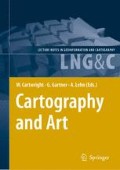Abstract
The transmission of geospatial facts is a crucial necessity since creatures move in space and need to communicate. We can observe the collective communication behaviour of insects, which has been brought to perfection during evolution and is highly effective for these creatures. Beside gesture, verbal or dance-based communication, traditional human artefacts for a visual description of space go back 8000 years.
Whereas oldest preserved maps show very large scales, topological relations or religious infiuenced descriptions in Europe, the late middle ages come up with grandiose techniques of 3D landscape paintings trying to transmit a real as well as fantastic world. Refinements of presentation methods for the third dimension showed up the high potential for military purposes soon. From that point onwards the happy couple of art and graphical description of space seemed to have filed for divorce. Military purposes aimed on developing high information-density and appropriate scales. In the end information extraction with these maps asks for enormous cognitive load. On the other hand landscape painting became more artistic, fantastic and as far as degenerated art in order to attract, unsettle or criticize.
Nowadays a wide range of topographic maps uses highly developed semiotics for specific media with the aim to document, visualize and archive geospatial information. As long as a map is created and methods for archiving exist, the task of cartography seems to be fulfilled. The question for and work on impact, individual understanding and progressive linguistics barely occur. Thus the evolution of pictorial landscapes seems to have reached its end.
This contribution faces the question if there is still a perspective for landscape painting in cartographic science – or have we really reached the end of pictorial landscape evolution in cartography. How open is the science community to expand the traditional understanding of a map? If the community is open-minded, are there further perspectives for the pictorial landscape evolution especially with latest technologies? Where are potentials for pictorial landscapes, or should it be called virtual cartographic environments? May cartography come to a marriage with graphic design again? Answers, thoughts as well as remarks on these questions will be given with strong relation to history, present scientifi c work and outstanding examples in graphic design.
Access this chapter
Tax calculation will be finalised at checkout
Purchases are for personal use only
Preview
Unable to display preview. Download preview PDF.
References
3D-Berlin: http://www.3d-stadtmodell-berlin.de/online/3d/seite0.jsp,accessed: 10/1/2008
3D-Stadtmodelle: http://www.stadtmodelle.com/, accessed: 10/1/2008
Barber P (ed) (2005) The Map Book, London: Weidenfeld & Nicolson
Burkart R (2002) Kommunikationswissenschaft – Grundlagen und Problemfelder, 4th ed, Wien-Köln-Weimar: Böhlau Verlag
Cartwright WE (2004) Using the web for focussed geographical storytelling via gameplay, Proceedings of UPIMap 2004, The First International Joint Workshop on Ubiquitous, Pervasive and Internet Mapping, Tokyo, Japan: ICA Commission on Ubiquitous Cartography, pp. 89–109
Chandler D (2002) Semiotics – The basics; New York: Routledge Taylor & Francis Group
Döllner J (2007) Real-Time Virtual Landscapes, in Cartwright W, Peterson MP, Gartner G (eds), Multimedia Cartography, 2nd ed, Berlin, Heidelberg: Springer
Englisch B (2002) Ordo orbis terrae. Die Weltsicht in den Mappae mundi des frühen und hohen Mittelalters. Berlin: Akademie
Englisch B (2003) Imago mundi. Der virtuelle und der reale Raum in den mittelalterlichen Weltkarten, in: E Vavra (ed) Virtualiät und Realität (Akten des 10. Symposiums des Mediävistenverbandes, Krems a. d. Donau, 23.–26.3.2003, Wien: Österreichische Akademie der Wissenschaften
EuroGeographics: http://www.eurogeographics.org/eng/00_home.asp, accessed: 10/1/2008
Hainzl M (2004) Zeichen an der Wand, Höhlenbilder – Felsbilder – Graffiti, Band zur Sonderaustellung, Lebensspuren Museum Wels,Wels:trod.ART Verlag
Kroeber-Riel W (1993) Bildkommunikation, Imagerystrategien für die Werbung, 5nd ed, Stuttgart: Kohlhammer Verlag
Kroeber-Riel W, Esch FR (2000) Strategie und Technik der Werbung, 5 nd ed, Stuttgart: Kohlhammer Verlag
Merten K (1999) Einführung in die Kommunikationswissenschaft; in Aktuelle Medien- und Kommunikationsforschung, Bd.: Grundlagen der Kommunikationswissenschaft 1999, Münster: Literatur-Verlag
Monmonier M (1996) How to lie with maps, 2 nd ed.; Chicago, London: The University Chicago Press
Nienhaus M (2005) Real-Time Non-Photorealistic Rendering Techniques for Illustrating 3D Scenes in their Dynamics, PhD, Potsdam:University of Potsdam
Nivala AM (2005) User-centred design in the development of a mobile map application. Licentiate Thesis, Helsinki: Helsinki University of Technology
Reichenbacher T (2003) Mobile Cartography – Adaptive Visualisation of Geographic Information on Mobile Devices; PhD, Munich: Tech. University
Schattschneider D, Emmer M (eds) (2003) MC Escher‘s legacy: a centennial celebration, collection of articles coming from the MC Escher Centennial Conference in Rome 1998. Berlin, London: Springer
Schmidbauer M (2004) Das kreative Netzwerk – wie unser Gehirn in Bildern spricht, Wien, New York: Springer
Shepard GM (1994) Neurobiology. 3rd ed, Oxford University Press
Steffenhagen H (2000) Wirkungen der Werbung: Konzepte-Erklärungen-Befunde, 2nd ed., Aachen: Wissenschaftsverlag Mainz
VRVis: http://www.vrvis.at/home.html, accessed: 10/1/2008
URL Supplemental fi gures can be found at the following locations:
Author information
Authors and Affiliations
Rights and permissions
Copyright information
© 2009 Springer-Verlag Berlin Heidelberg
About this chapter
Cite this chapter
Jobst, M. (2009). Marriage and Divorce: Is the Evolution of Landscape Paintings Ending in the Fields of Topographic Cartography and Graphic Design?. In: Cartography and Art. Lecture Notes in Geoinformation and Cartography. Springer, Berlin, Heidelberg. https://doi.org/10.1007/978-3-540-68569-2_5
Download citation
DOI: https://doi.org/10.1007/978-3-540-68569-2_5
Published:
Publisher Name: Springer, Berlin, Heidelberg
Print ISBN: 978-3-540-68567-8
Online ISBN: 978-3-540-68569-2
eBook Packages: Earth and Environmental ScienceEarth and Environmental Science (R0)

